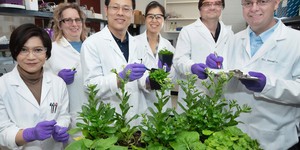Summary
Introduction
Have you ever wondered how plants take up water from the soil? Water uptake in plants is quite complex and involves a process called osmosis. Osmosis makes the water from the soil move into the roots of the plant. But what drives the water from the soil into the plant cells? In this activity, you will do an experiment with potatoes to find out!
Materials
- Distilled water
- Measuring cup
- Several potatoes
- Apple corer or cork borer. Alternatively, you can use a cutting board and knife.
- Table salt
- Scale
- Plastic cups or glasses (3)
- Spoon
- Ruler
- Paper
- Pen
- Timer
- Paper towels
- Optional: Graphing paper
- Optional: Scale
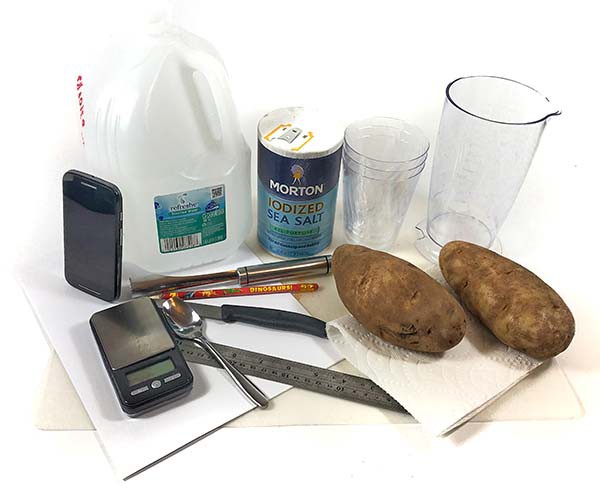 Image Credit: Svenja Lohner, Science Buddies / Science Buddies
Image Credit: Svenja Lohner, Science Buddies / Science Buddies
Prep Work
- Prepare three different saltwater solutions. Label the three cups with "0 grams", "2 grams", and "4 grams". To each of the cups, add 100 mL of distilled water.
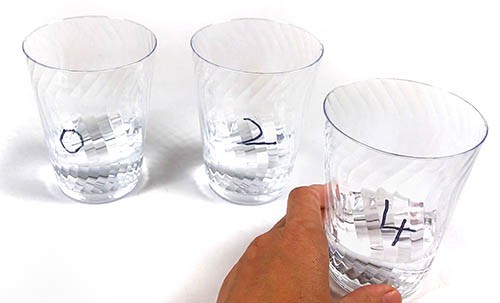 Image Credit: Svenja Lohner, Science Buddies / Science Buddies
Image Credit: Svenja Lohner, Science Buddies / Science Buddies
- Weigh out 2 grams of table salt and add it to the cup that says "2 grams". Then weigh out 4 grams of table salt and add it to the cup labeled "4 grams". Use a spoon to mix the solutions until all the salt is dissolved.
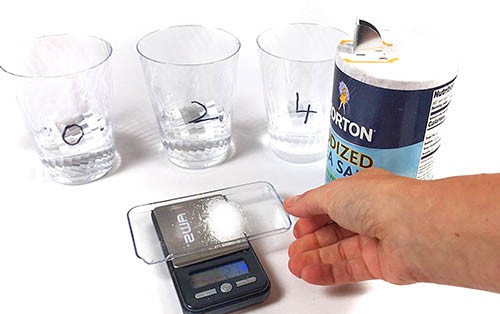 Image Credit: Svenja Lohner, Science Buddies / Science Buddies
Image Credit: Svenja Lohner, Science Buddies / Science Buddies
- Use the apple corer or cork borer to prepare at least three potato cores. Ideally, you prepare 9 cores, so you can do your experiments in triplicates. Push the corer or borer all the way through the potato and remove the core carefully so the potato piece stays intact. Alternatively, you can cut the potato into strips that should all have the same dimensions. They should be at least ½ inch thick and two inches long.
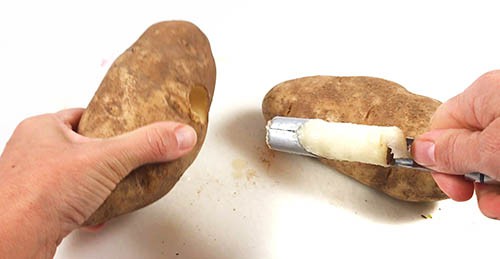 Image Credit: Svenja Lohner, Science Buddies / Science Buddies
Image Credit: Svenja Lohner, Science Buddies / Science Buddies
- Create a table where you can enter the starting measurements (length and diameter) and end measurements of each potato strip for every salt concentration (0, 2 and 4 grams).
- Remove the potato skin from your cores or strips and rinse them quickly with water.
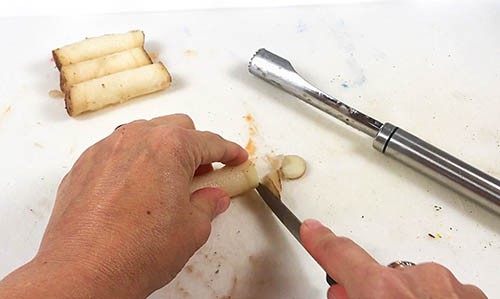 Image Credit: Svenja Lohner, Science Buddies / Science Buddies
Image Credit: Svenja Lohner, Science Buddies / Science Buddies
- Then take a ruler and cut each of the strips into exactly the same length (to the millimeter). Enter the start length of each potato strip into the table.
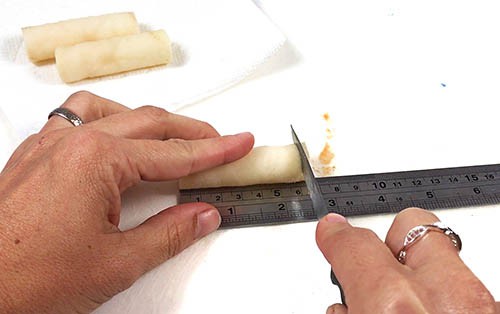 Image Credit: Svenja Lohner, Science Buddies / Science Buddies
Image Credit: Svenja Lohner, Science Buddies / Science Buddies
- With a ruler measure the diameter or width of each potato strip as well. Again, enter your measurements into the table.
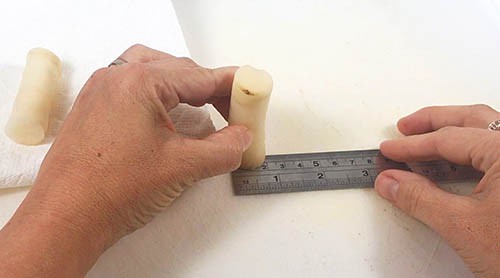 Image Credit: Svenja Lohner, Science Buddies / Science Buddies
Image Credit: Svenja Lohner, Science Buddies / Science Buddies
Instructions
- Put one potato strip (or three if you do triplicates) into each of the cups with saltwater. While you do that, feel the potato strips with your fingers and try to flex them a little bit.How do they feel? Are they easy to bend?
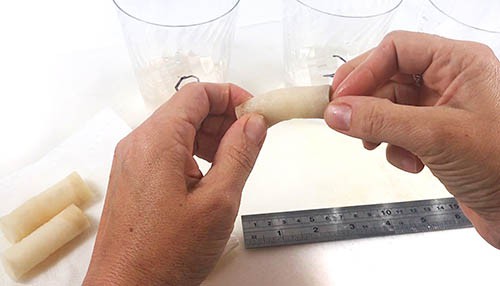 Image Credit: Svenja Lohner, Science Buddies / Science Buddies
Image Credit: Svenja Lohner, Science Buddies / Science Buddies
- Set your timer to 30 minutes and start it. Let the potato strips sit in the different saltwater solutions for the whole time.What do you think will happen to the strips in each of the cups?
- After 30 minutes, inspect the potato strips inside the saltwater solution.Do you notice any changes?
- Take the potato strip(s) out of the "0 grams" cup and place them on a paper towel. While doing that, feel them again and try to bend them slightly.How do they feel? Are they easier or more difficult to bend than before?
- Use the ruler to measure the exact length and diameter (to the millimeter) of each of the potato strips and write the results in your table.What do you notice about the potato strip measurements?
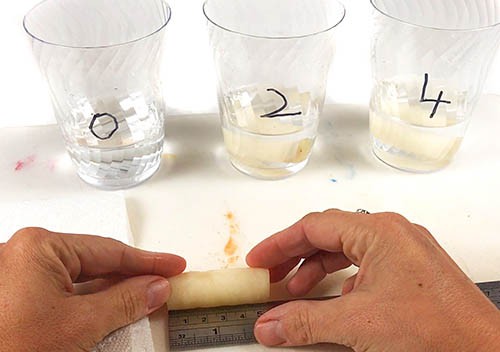 Image Credit: Svenja Lohner, Science Buddies / Science Buddies
Image Credit: Svenja Lohner, Science Buddies / Science Buddies
- Next, take the potato strips from the "2 grams" cup. Again, feel them first in your hands and then measure their lengths and diameter. Write your results into the table.What changed about these potato strips?
- Finally, repeat the same steps with the potato strips in the "4 grams" cup. Again, write your results into the table.Are your results for these similar or different compared to the other ones?
- Compare all your potato strips and the results in your table.How did the length and diameter of the potato strips change in each cup? Can you explain your results?
Cleanup
- Discard the saltwater solutions in the sink. Throw the potato strips into the compost and clean up your workspace.
What Happened?
Did you make your potato strips shrink and expand? You should have! At the beginning all the potato strips should have had the same length and should have all felt the same. However, when you put them into the different saltwater solutions this changes. Whereas the potato strips in the "0 gram" cup got larger in size, the other potato strips probably got shorter after leaving them in the saltwater for 30 minutes. (If you didn't see any significant changes after 30 minutes, leave the potato strips in the saltwater solutions longer).
The shrinking and expanding of the potato strips is due to osmosis. Potatoes are made of cells and their cells have cell walls that act as semipermeable membranes. The 0 grams saltwater solution is hypotonic compared to the solution inside the potato cells, which means that it contains less salts and more water. To balance out these concentration differences, the water from the cup moves inside the potato cells where there is a higher concentration of salts and less water. The incoming water in the potato cells pushes on the cell walls and makes the cells bigger. As a result, the whole potato strip gets bigger. The opposite is the case in the higher concentrated salt solutions. Once the salt concentration in the cup gets higher than inside the potato cells, water moves out of the potato into the cup. This leads to shrinking of the potato cells which explains why the potato strips get smaller in length and diameter.
If you made the graph you should have noticed that there is a salt concentration at which the potato strip neither expands nor shrinks. This should be where your data curve and your start length line intersect. At this point, the salt concentration inside the potato cells and inside the cup are exactly the same. No water is moving in this case as the concentrations are already balanced. Solutions with the same salt concentrations are also called isotonic.
Digging Deeper
Rainwater is almost never pure. It always contains some dissolved mineral salts. Animals and plants need these salts to grow, develop, and stay healthy. Each water source carries different amounts of these salts which means that their salt concentrations are different as well. If you compare two solutions with different salt concentrations the higher concentrated solution is called hypertonic whereas the lower concentrated solution is called hypotonic. Nature always wants to balance a system that is not balanced. For example, if you mix water with two different salt concentrations, the salts don't stay separated but spread out evenly through the solution until the salt concentration is the same everywhere.
You will find a similar reaction if you separate two salt solutions with a semipermeable membrane. A semipermeable membrane is like a barrier that only lets certain particles pass through while blocking others. This type of membrane usually lets water pass through but not the salts that are dissolved in the water. When you separate two salt solutions that have different salt concentrations with a semipermeable membrane you create a concentration gradient across the membrane. This means that the salt or water concentration on one side of the membrane is different than on the other side. Again, nature wants to balance out this difference. Since only water is able to move through the membrane, the water will start moving from the area of lower salt concentration (which has more water but less salt) to the area of higher salt concentration (which has less water but more salt). This water movement will only stop once the salt and water concentration on both sides of the membrane is the same.
The process of moving water across a semipermeable membrane from an area of lower salt concentration to higher salt concentration is called osmosis. Plants use this process to their advantage for water uptake. They intentionally create an environment of high salt concentration in their root cells which are in contact with the moist soil. The cell walls act as a semipermeable membrane that only let water through. Because the water outside the root cells has a lower salt concentration water starts moving into the root cells due to osmosis. The water entering the plant fills up the cells and makes the plant sturdy. Osmosis, however, works in both directions. If you put a plant into water with a salt concentration that is higher than the concentration inside its cells, water will move outside of the plant to balance out the concentration difference. As a result, the plant shrinks and eventually dies.
Ask an Expert
For Further Exploration
- In addition to taking the measurements of your potato cores, weight each of the potato strips before and after soaking them in salt solution. How does the mass of the potato strips change in each salt solution?
- Leave the potato strips in the saltwater solutions for a longer time period. How do they look if you let them soak in the saltwater for 1 hour or overnight?
- If you have graphing paper, make a graph of your results with the salt concentration showing on the horizontal axis and the potato strip length or diameter at the end on the vertical axis. Connect each of the data points to make a line graph. Then draw a horizontal line through the vertical axis where your starting potato strip length was. Based on your graph can you find a salt concentration at which the potato strip length should not change at all?
- Repeat the experiment with different salt concentrations. Test 1, 3, or 5 grams of salt. How do these results compare to the 0, 2, and 4 grams of salt?
- Does the experiment work with other vegetables or fruits? Try it to find out!
Related Resources
Activities
Links
- Biology Dictionary: Osmosis
- Scotty's Action Sports Network: Why can't freshwater fish live in saltwater?






